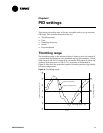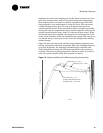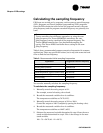
Calculating the sampling frequency
CNT-APG002-EN 15
®
6. Calculate two-thirds (66%) of the change in measured variable deter-
mined in step 4. Add this value to the initial temperature to deter-
mine at what point two-thirds of the total change occurs.
In the example, 0.66 × 50°F = 33°F, so two thirds of the total change
occurs at 70°F + 33°F = 103°F (0.66 × 28°C = 18°C; 21 + 18 = 39°C).
7. Again, set the analog output to 0% and allow the measured variable
to stabilize.
The measured variable stabilizes at 70°F (21°C).
8. Control the output to the value used in step 3 and record the time it
takes to reach the two-thirds point determined in step 6. This is the
system time constant.
The time it takes to reach 103°F (39°C) is 2.5 minutes (150 seconds).
9. Divide the system time constant by 10 to determine the initial sam-
pling frequency.
150 seconds ÷ 10 = 15 seconds.
Figure 13 illustrates the procedure described above.
Figure 13: Determining the system time constant
Note:
The system time constant is the time it takes to reach 63.21% of
the difference between the start point and the end point. How-
ever, two-thirds (66%) is accurate enough for most purposes.
System time
constant
Time (minutes)
Space temperature (°F)
Initial value (valve closed)
Final value (valve open)
2/3 of total change


















